Back on Easter Sunday, which was two or three weeks ago if my calendar is accurate, which I doubt since it still has 2010 written on it, my wife and I met up with my parents to celebrate easter in the traditional way: at an all you can eat Chinese buffet. Because what better way to celebrate the joys of spring and the spread of new life than to eat animals cooked in a questionable fashion?
As I pretty much always do when I leave the flat for a reason that isn’t work, I took my camera with me. We arrived in Kingston a little early to meet with my parents for the meal, which was the plan (that doesn’t always work, however, usually we aim to leave early and arrive just in time. That’s my fault, most of the time). On our route to the restaurant there is the All Saints Church, which had caught my eye previously when I either didn’t have my camera or the time to take the photo (possibly both).
When I had first sighted the church a few months ago, there was one shot that I saw immediately, and that is the first one I took on this trip.

On this occasion, however, I was able to take a little more time and explore the grounds some more to see what else the church had to offer.
To begin with I wandered around the outside of the church. On the other side of the entrance pathway there was some kind of stone plinth, presumably used for human sacrifice or sitting down or some such thing, which presented me with something more interesting to put in the foreground of the image.
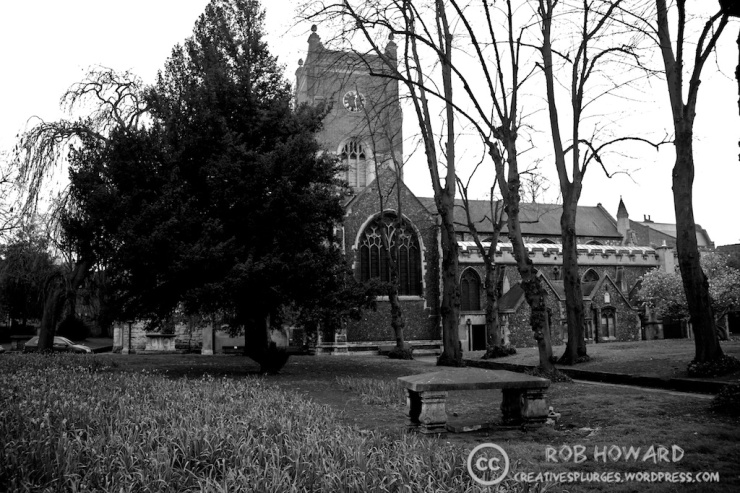
Now, architectural landscapes are one thing, but if there’s a shot I love doing it’s a perspective shot. Fortunately the church has a nice pathway that conforms to the laws of physics.
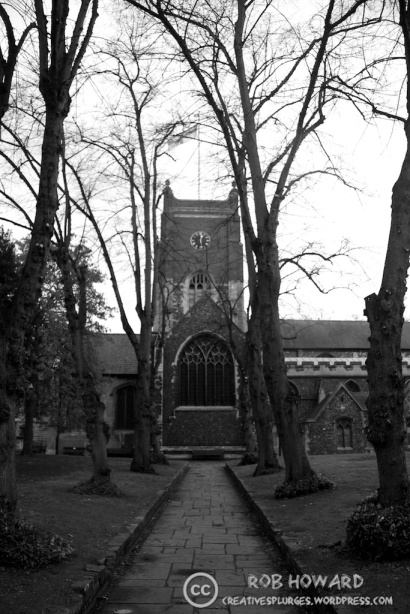
Despite it being the spring festival, and having had a spell of warm weather (now sadly departed), the trees were still largely devoid of leaves. This isn’t exactly a problem, I love the look of a spindly, leafless tree; it is one of the things I love most about shooting in winter, and for these shots it certainly helped improve the barren, lifeless atmosphere of the images.

It was lightly raining as I began my trek around the grounds – you can see this in the image above, there is a white dot in the centre of the frame from a speck of rain on the lens. Annoying, but not the end of the world. Anyway, I’m not about to let a few drops of rain stop me, I survived the Bournemouth floods of 2011.
This next shot is a little late for St George’s Day, but that’s all I can think of to segue this next photo.
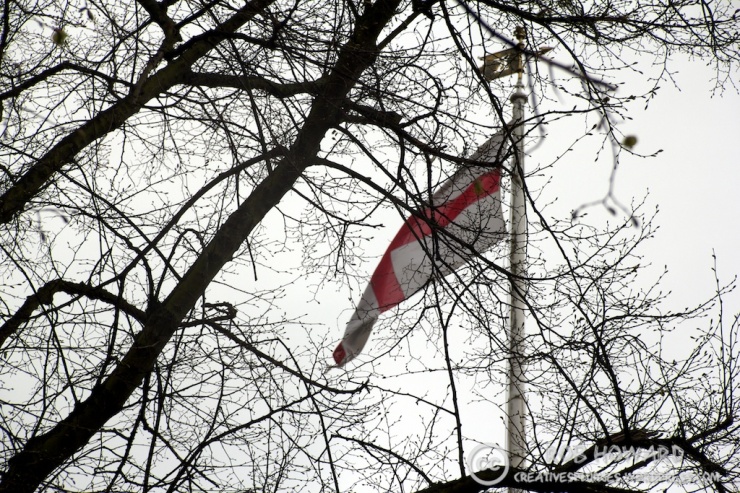
Continuing the sense of doom and futility, I continued around the grounds, and took this next image, of daffodils – traditionally one of the signs of spring – wilting and dying despite the rain.
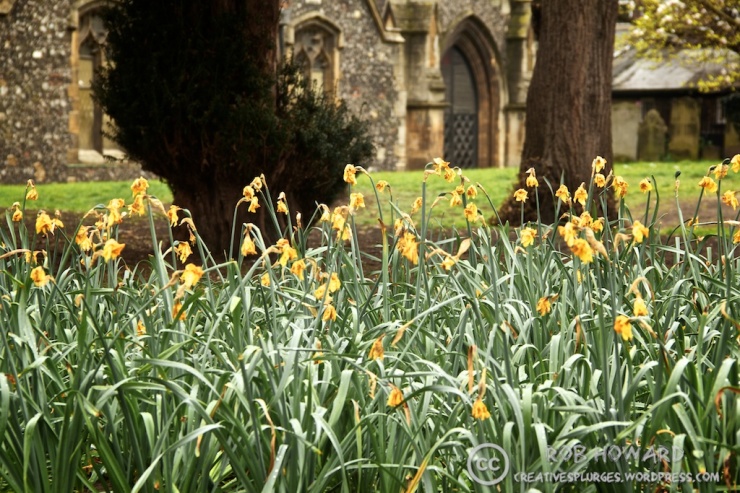
I played about a little with the colour in this shot; I lowered the saturation of the colours a tad, upped the ‘definition’ setting (which affects the “local contrast”, according to the software – it appears to adjust the contrast at the subjects’ edges) and bumped the contrast a tiny bit.
Around the back of the church is a graveyard. Which is as good a time as any to switch back to black and white. I should add that this post-processing of the images was planned before I even pushed the shutter, it’s not just a spur of the moment edit.
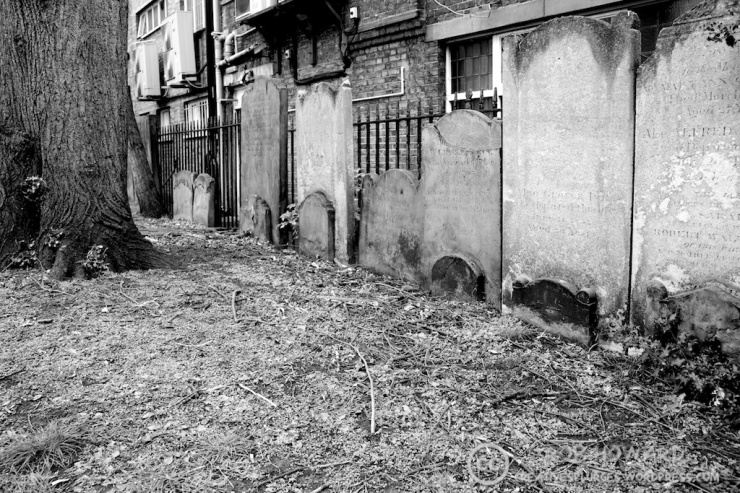
I love the way the monochrome has brought out the textures of the grass and the tree trunk. It’s also helped to conceal the slightly more modern buildings behind the gravestones which kind of ruin the look a little.
Monochroming has had a similar effect on this next shot. Although in related news, my spellchecker is telling me ‘monochroming’ is not a word. Silly spellchecker. How would you rather I spell it? Monochromaticising? (It actually suggests ‘mono chroming’ which sounds altogether more salacious)
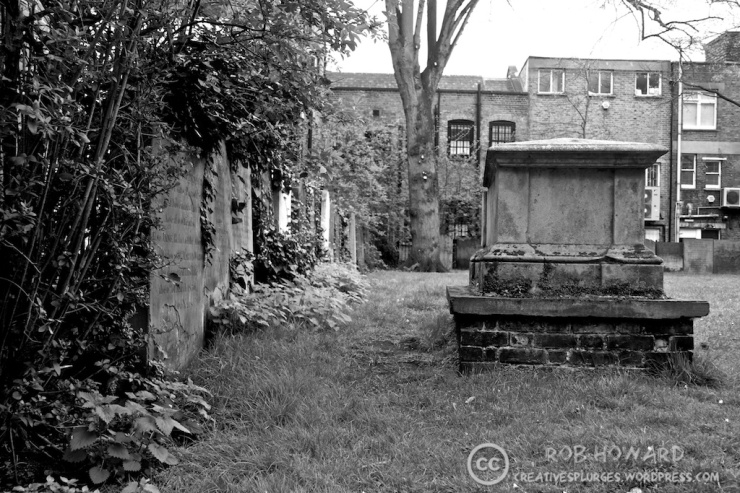
By this point the faint drizzle had subsided. Perhaps I’m making it sound wetter than it was. It was a few drops of what I hope was mostly water. It did, however, have quite a good effect on the flowers in a pot by the back entrance to the church (I thought churches frowned upon using the back entrance, but that’s another matter entirely). They ended up with lovely little water drops on them.
Time, then, to break out the macro lens. Oh goody. I love that lens.
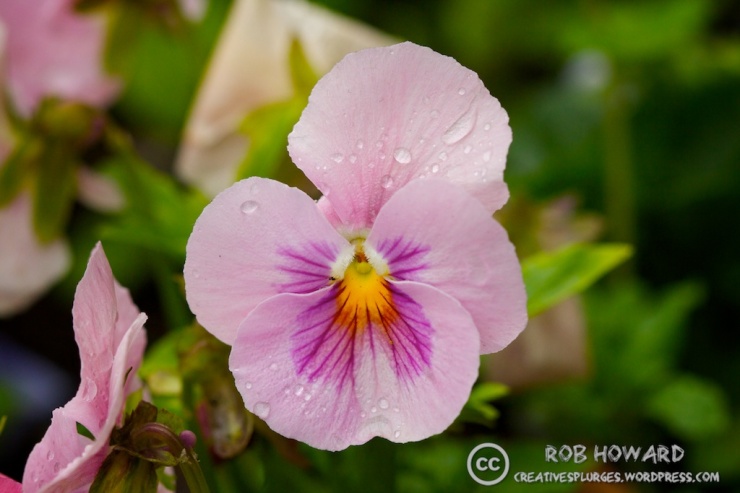
C’mon now, macro lens, you can get closer than that.
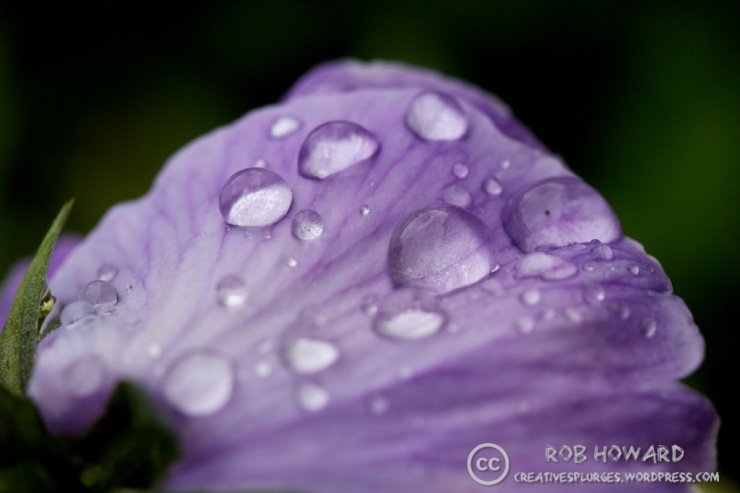
That’s better. Although the tiny bit of green leaf on the left seems to be the bit most in focus.
I’ve not had much opportunity to take shots like this, in part because I’ve not been outside at that magic time just after it’s rained when the droplets are still around (quite often it’s because it only rains when I’m at work, and is relatively sunny at weekends. Which I’m reasonably sure I shouldn’t be complaining about). I’ve been wanting to photograph something like this since H₂O by Joanna first did it a few months ago.
It is perhaps a pent-up desire to take this sort of photo that made me stay at this small plantation taking many variations on this simple but appealing theme.
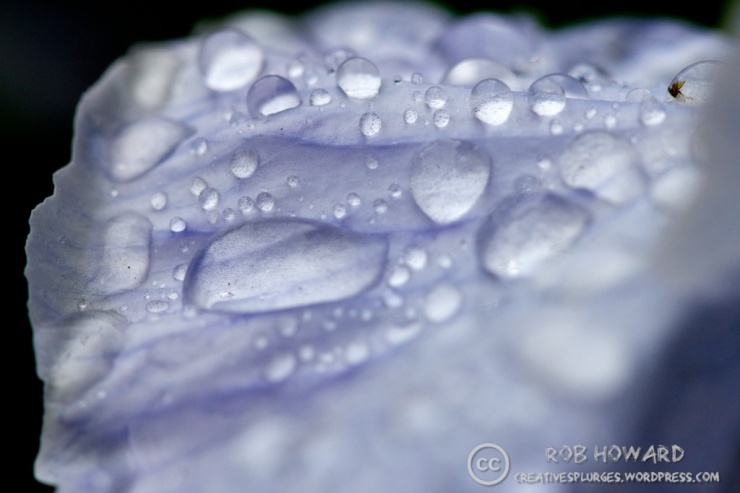
I haven’t spent much time photographing the rain. I’ve taken a few shots out of my window from time to time but ultimately I get very worried about water damaging my camera. So to be out just after the rain where I can grab images like these without fear was fantastic.
That isn’t to say all of the flowers had water on them. These two tiny flowers somehow escaped the rain, perhaps by virtue of them being not much bigger than a drop of water.
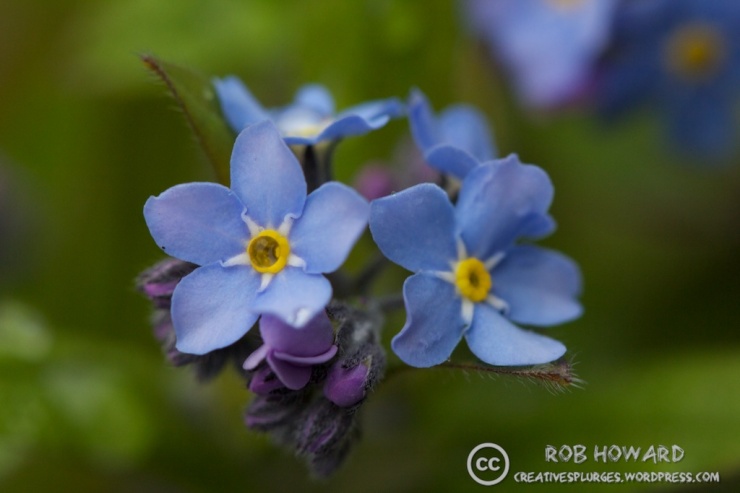
I think that may actually be a small drop of water on the whatever the middle bit of a flower is called. Iris? That’s not right. If I remember A-level biology correctly (which is by no means a given) then those are the sex bits. For some reason some things I’m keen to research for a post in order to appear knowledgable and others I prefer to attempt to be humorously ignorant. Today I chose the latter with the ambition of a flower gonad joke. Way to lower the tone, Rob, you doofus.
Ahem.
I really liked these little flowers. I loved their colour, their size, and their shape. This is another occasion when the sense of scale has been lost in the macro shooting; hopefully you can sense that these were delicate little things.
They were often found alongside deep green leaves and some purple buds, making for some amazingly nice arrays of colours.
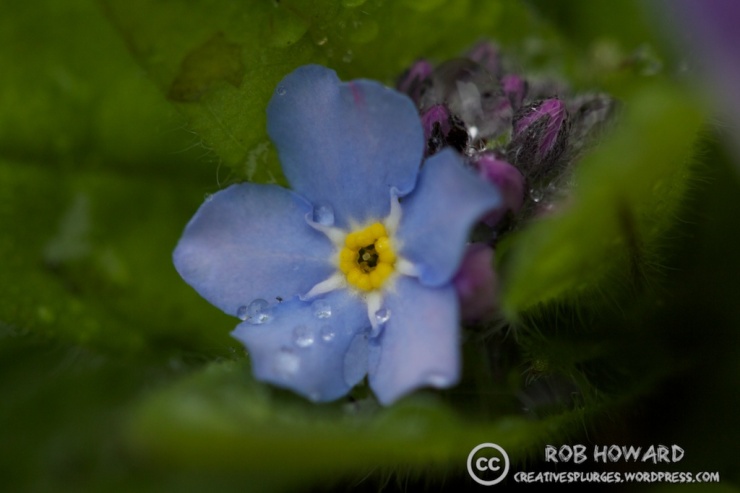
I was perhaps most impressed by the vivid greens on display from the leaves. It might have been the weather, or the leaves themselves, or even, maybe, I might be getting better at this, but I don’t usually see leaves this brilliant a green. Usually the season is colder and the leaves are brown, or the sun is brighter and the leaves are bleached out a little by the sunlight. Perhaps this overcast weather is best for plant shooting.

I’m still pleased by this lens’s ability to pick out the tiny details, such as the tiny hairs on the edge of this leaf. I also continue to think it would be really quite useful if the lens could report back to the camera the focussing distance or magnification ratio of each photo – or if it already does this, then it would be cool if Aperture could read this from the image metadata. To elaborate a little: the focus ring on the macro lens includes the magnification ratio, which is the ratio of the actual subject against the image on the sensor. This goes to 1:1, that is, the image on the sensor is life-size. Reporting this info back would allow me to gauge how big things are in the image.
Anyway, I’ve bored you enough with technical musings. Here’s more of those flowers, which in this shot look more like care decorations.
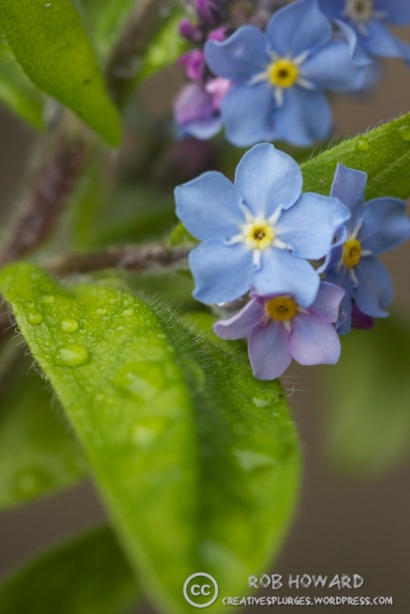
Up to this point I had been shooting with an aperture of f/5.6, however the macro’s aperture can open up far more than that, all the way to f/2.8. Depending on the subject, and indeed the distance from which I am shooting it, I often try to avoid opening out the aperture this much because at close distances the can create a depth-of-field narrower than Victoria Beckham.
For this blog however I’m nothing if not experimental, so I tried shooting at that bigger aperture to see how the images came out. For those of my readers whose eyes tend to gloss over when exposed to the technical details of photography (my wife being one of them), if you’re still actually reading, this is the point where the gibberish becomes a pretty picture. Or as close an approximation of one as I’m able to produce.
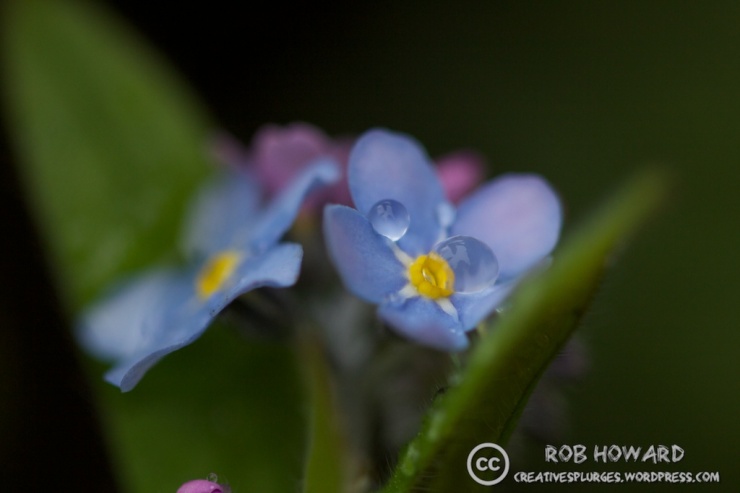
In this shot, the narrow depth of field has worked primarily because of the water droplets; without them as the point of focus this would be a picture of a flower that isn’t all in focus.
I eventually found a couple of the little blue flowers with water droplets in almost exactly the right place for an interesting photo.

It was around this point that I realised I was getting a bit obsessed with this single planter in the grounds of a church, and I should probably make my way back to my wife who was sitting on a bench waiting for me just outside the grounds.
Despite my best efforts, well, fine, not my best efforts, but at least half-arsed efforts, I didn’t make it directly back to my wife. I might possibly have stopped at a few points along the way.
Firstly, I stopped to get a shot of the wall, which had interesting textures that I posited would look nice in black and white.

Then I came across a dedication, covered a little in strands of grass. For this shot I didn’t bother capturing the wording, that wasn’t important to me. I liked the way the grass played over the lettering.
Due to the look of the image, I figured some slight desaturation would work better than full-on monochroming.
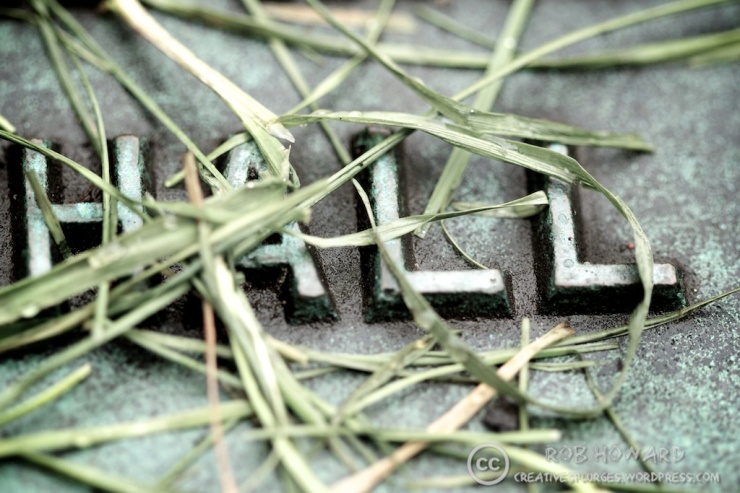
Down on the path, near the base of the walls, some ants were hard at work doing whatever it is ants do. Plotting world domination, probably – who wouldn’t with their numbers behind them? Have you seen ant colonies? There must be literally hundreds of ants in the world.
Anyway, I’d been meaning to try out the macro lens on insects, so I tried to photograph one of them.
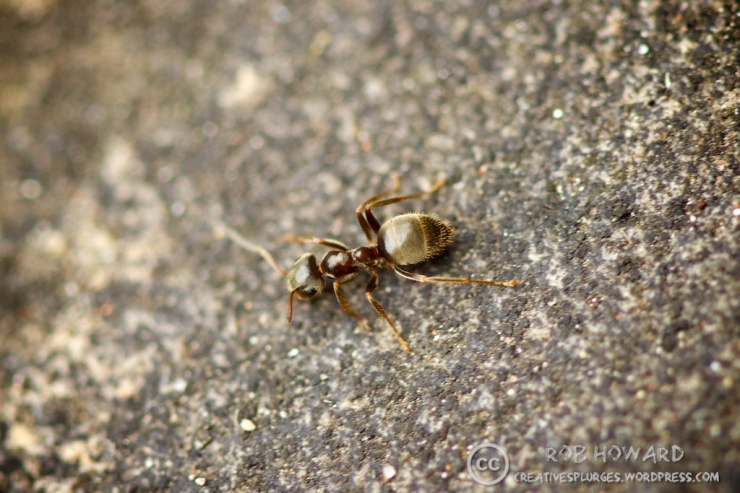
This is pretty close, although admittedly I have cropped the image to about 40% of its original size. It has still managed to remain sharpness however, so maybe I won’t be quite as upset if I have wasps interrupting picnics or barbecues this summer, provided I’ve got my macro lens on me.
My final shot of the day before I located my wife and went to a pretty decent all I could eat Chinese buffet (which, coincidentally, is quite a lot) was a shot of a hinge to one of the doors in the church. It had an old, tough-looking spider’s web on it, which I hoped would come out quite nicely in black and white. Let’s take a look.

My wife described this image as ‘beautiful’, which is something considering her usual opinion of spiders in general. I agree though, there is something very appealing about the spider’s web standing out against the texture of the hinge. I’m a little disappointed however by the strip on the left side which seems pretty overexposed.
Looking back over these images, I’m pretty pleased with them. Most of them have actually been post-processed as I envisioned before I even took the picture, which is a bit of a departure from my usual ‘TAKE ALL THE PICTURES’ attitude when shooting which sometimes translates to a ‘how can I make this an interesting photo?’ in the processing stage. Forward thinking has never really been one of my strong points so this seems to be a good thing.
Let me know what you think in the comments, and thanks for reading.

i really enjoyed the descriptions and the photos. thank u for sharing with me
LikeLike
thanks for taking us with you on this journey…great way you describe each step of the way and your photos are simply beautiful!
LikeLike
and only now I saw the part I had to approve first…thank you so much for mentioning me, I feel honored 😀
LikeLike
Fantastic!
LikeLike
I like your blog and your photoes. This one about the Church, that is in Kingston reminded me the Church behind the Imperial College, when you walking through the campus, the back of the campus, there is a little path that ended up in Old Brompton road and there is this Church I don’t remember the name but for some reason those picture reminded me about it
LikeLike
Thanks for commenting. I’m pleased you’re enjoying my work!
LikeLike
The door hinge is exactly wot-she-said, beautiful. Can I vote that as my favourite photo you’ve taken for your 100th post?
The first few images of the church are good in monochrome, but for my very personal taste, not contrasty enough. The pop isn’t quite there. But the atmosphere of the rainy day certainly is, so mission achieved?
Greens in the flower images really do stand out, and I love the clarity. Especially that last one with the raindrop in exactly the right place! I really REALLY want that lens. Must dig down the sides of the sofa cushions tonight.
LikeLike
I was debating with myself (one of the many signs of madness I exhibit) whilst processing these photos on the right amount of contrast. I was very conscious of the images becoming a bit too dark. I may play about with them a bit more.
Your vote is duly noted for the 100th post vote. I still need to collate that shortlist…
LikeLike
I think that actually, this looks like the same problem I felt I had with the first couple of mine I just posted which we disagreed on. I wonder if we never could reach a satisfactory result just because conditions were not right on the day? At least not without over processing…?
LikeLike
Maybe. I’d like to think we can work around or at the very least adapt to less than preferable conditions, but we both seem to have struggled in similar ways in similar conditions. Although I think if I had something more interesting than a solid grey sky (some clouds would have been nice) it might have helped; the grey sky is close to being blown out.
I returned to the opening church images, however, and had a tinker with them to boost the contrast.
LikeLike
Absolutely agree that the key problem with these shots that we’ve both taken is the flat grey sky. Although that grey-ness (?) works really well if you’re doing macro or just close crops, because the colour really bounces out, it really does nothing for bigger vistas! Have you tried a grad fill over the sky just in case there was any texture or variation there at all?
I like the contrast in the newly tinkered images, I still think it can be very subjective and I know I am partial to more contrast than many would probably like, but these are certainly more pleasing to my eye!
LikeLike